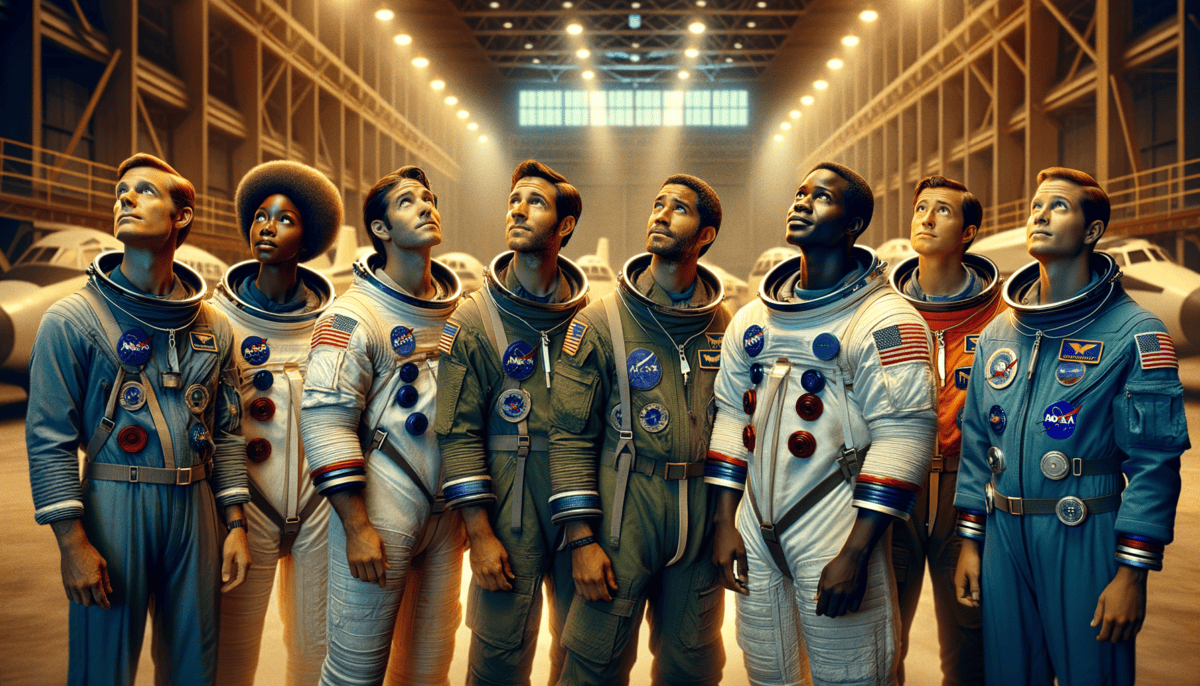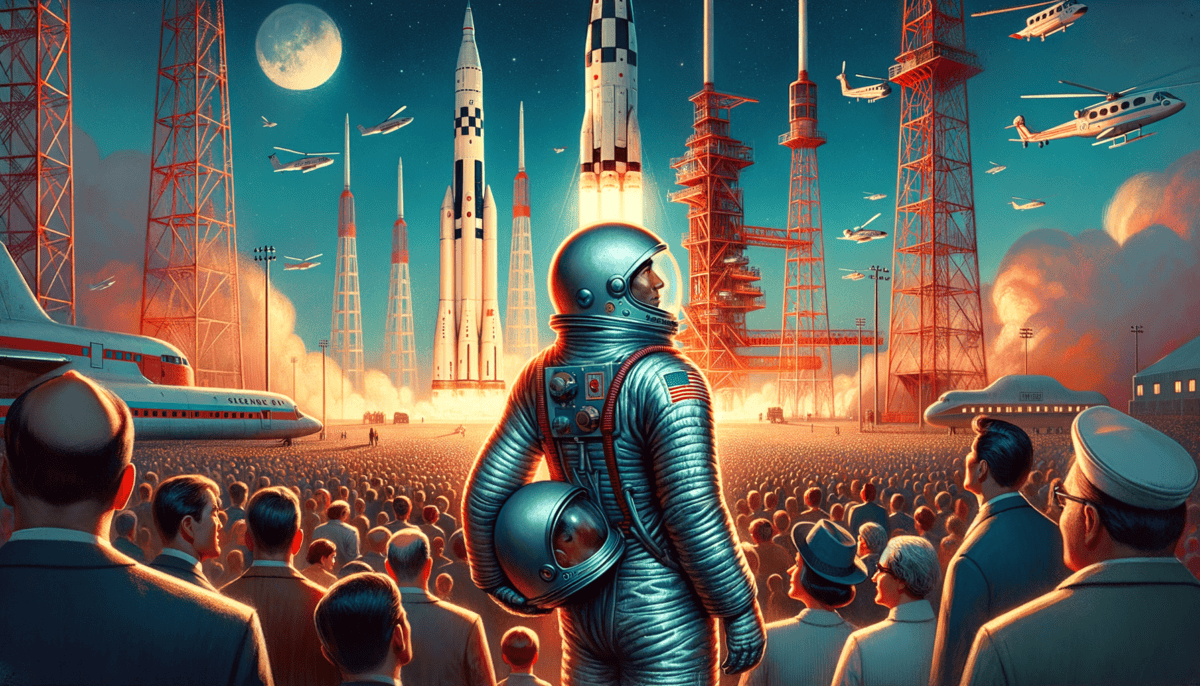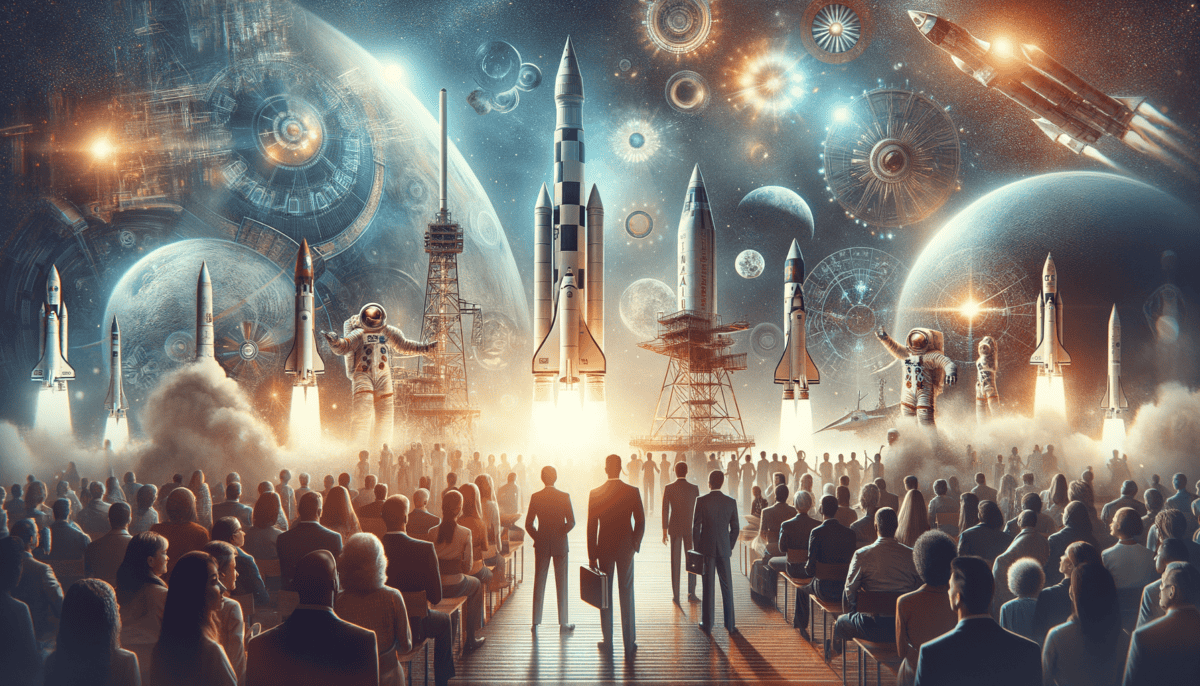The Race to Space
The year was 1957. People all over America looked up at the night sky with worry. A small beeping sound was coming from space – but it wasn't from the stars. It was from Sputnik, a shiny metal ball that the Soviet Union had sent into space. ️
"Did you hear that?" Tommy asked his dad as they stood in their backyard. "The radio says the Russians put something up there in space!"
His dad nodded slowly. "They sure did, son. And now America needs to catch up."
A New Challenge
America wasn't used to being second best at anything. The Soviet Union's success with Sputnik made many people nervous. President Eisenhower knew he had to do something big. Really big!
"We choose to go to space not because it is easy, but because it is hard." – These words would later inspire millions of Americans.
The President created a special group called NASA. Their job? To send Americans into space!
The Big Problem
But getting to space wasn't easy. No one had ever done it before! Scientists had to figure out lots of tricky things:
• How to make rockets strong enough
• What astronauts would need to survive
• How to bring people back safely to Earth
A Nation United
All across America, people got excited about space. Kids built model rockets. Teachers talked about science more than ever. Television shows were all about space travel. Everyone wanted to help America reach for the stars! ⭐
"I want to be an astronaut when I grow up!" became something children everywhere started saying.
The Promise of Tomorrow
Scientists worked day and night. Engineers drew plans for spaceships. Factories started building new kinds of machines. America was getting ready for its biggest adventure ever.
"We're going to do it," said Dr. Robert Gilruth, one of NASA's leaders. "We're going to send brave Americans into space."
The whole country held its breath. The space race had begun, and America was determined to win. But first, they needed to find some very special people. They needed astronauts who would be brave enough to ride rockets into the unknown…
Little did anyone know that this was just the beginning. Soon, America would pick seven amazing pilots who would change history forever. These heroes would be called the Mercury Seven, and their story was about to begin.
The Magnificent Mercury Seven
The phones at military bases across America were ringing. NASA was looking for some very special people. They needed the bravest pilots in the country! ♂️
Finding Heroes
“We need the best of the best,” said Bob Gilruth, the NASA leader. He and his team looked at over 500 pilot records!
• Pilots under 40 years old
• Perfect health
• Not too tall (the spaceships were tiny!)
• Lots of flying experience
• Very brave hearts
Meet the Seven
After many tests, NASA picked seven amazing men. People called them the Mercury Seven! Let’s meet them:
Alan Shepard – The competitive one who loved to race ♂️
John Glenn – The natural leader with a big smile
Gus Grissom – The quiet but super smart one
Scott Carpenter – The dreamer who loved the stars ⭐
Wally Schirra – The funny one who made everyone laugh
Gordon Cooper – The youngest and most daring one
Deke Slayton – The tough one who never gave up
Training Time!
The astronauts had to train really hard. It was like going to the toughest school ever!
“This is harder than anything I’ve done before,” said John Glenn, wiping sweat from his face.
They had to:
• Spin in giant machines that made them dizzy
• Learn about space and stars
• Exercise every single day ️♂️
• Practice sitting still for hours
• Learn how to use their spaceship
Living Like Stars
Everyone wanted to meet the Mercury Seven! They were on TV, in magazines, and newspapers. Their kids were proud to say, “My dad’s going to space!”
“Sometimes I can’t believe this is really happening,” Scott Carpenter told his family. “We’re actually going to fly in space!”
Getting Ready
Each astronaut had their own special job. John Glenn helped design the spaceship controls. Alan Shepard worked on emergency plans. They all helped each other and became good friends.
Team Spirit
The seven men became like brothers. They worked together, lived near each other, and their families became friends too.
“We’re not just a team,” said Wally Schirra. “We’re a space family!”
Every night, they would look up at the stars together. Soon, one of them would be up there, making history. But who would be first? And would everything work the way it should?
The Mercury Seven were ready for their big adventure. Now they just needed their spaceships. Engineers were working day and night to build something that had never been made before – a safe way to send humans into space…
Building Dreams and Rockets
In a big building in Florida, hundreds of people were working hard. They had an amazing job – to build America’s first spaceship!
The Special Space Room
The Mercury capsule was tiny! It looked like a small bell. Inside, there was just enough room for one astronaut to sit.
“It’s like sitting in the world’s fanciest chair,” laughed Alan Shepard when he tried it first.
• One comfy seat
• Lots of blinking lights
• Special windows to see Earth
• Controls to fly the ship
• Emergency buttons
Making it Safe
Max Faget was the chief designer. He wanted to make sure the astronauts would be super safe. ️
“We have to think of everything that could go wrong,” Max told his team. “Then we fix it before it happens!”
The engineers worked on three big problems:
1. How to keep the astronaut from getting too hot
2. How to make sure they could breathe in space
3. How to bring them safely back to Earth
The Big Test
Before any astronaut could fly, they had to test everything! They sent monkeys named Sam and Ham to space first.
“If the monkeys come back happy, we know it’s safe,” said Gordon Cooper. The monkeys did great!
The Mighty Rockets
To get to space, they needed super strong rockets. The Redstone rocket would take the first flights up and down. The bigger Atlas rocket would go all the way around Earth!
Working Together
Scientists, engineers, and workers from all over America helped build Mercury. Some made the spacesuits. Others built radio systems. Everyone had an important job!
“It’s like building the biggest puzzle ever,” said one engineer. “Every piece has to fit perfectly.”
Ready for Launch
After months of hard work, the Mercury capsule was ready. It shined like a silver bell in the sun. The rockets stood tall and proud on the launch pad.
The control room was filled with clever people ready to help guide the missions. They had computers (though not as smart as today’s phones!), radio systems, and tracking stations all around the world.
“Now comes the exciting part,” said John Glenn with a big smile. “Who gets to fly first?”
The Mercury team had done everything they could to make the spacecraft safe. They checked everything three times! Now it was time for the biggest test of all – sending the first American into space.
At Cape Canaveral, a silver rocket pointed to the sky. Soon, it would carry a brave astronaut higher than any American had ever gone before…
The Flight That Changed Everything
The morning of May 5, 1961, was special. Alan Shepard woke up very early. Today he would fly to space!
Getting Ready
Alan ate a big breakfast of eggs and toast. Doctors checked to make sure he was healthy. Then, helpers got him into his shiny spacesuit.
“I feel like a superhero in this suit!” Alan said with a smile.
The Big Walk
Walking to the rocket was exciting! Cameras flashed as Alan walked out. He waved to everyone. The Mercury capsule sat on top of the tall Redstone rocket. They named it Freedom 7.
• One small window
• Radio to talk to Earth
• Special seat that moved
• Buttons and switches
• Emergency tools
The Long Wait
Alan climbed into Freedom 7. He had to wait a long time. The countdown kept stopping for little problems.
“I’ve got to go to the bathroom!” Alan said after waiting for hours. Everyone laughed. But it was a real problem!
3…2…1…Liftoff!
Finally, the rocket roared to life! Fire and smoke filled the air. Freedom 7 started to climb higher and higher.
“Roger, liftoff, and the clock is started!” Alan said as his journey began.
Flying High
The ride was bumpy at first. Then everything got smooth. Alan could see the Earth through his window. It was beautiful!
He flew:
• Higher than any airplane
• Faster than anyone had gone before
• All the way to space!
Coming Home
After 15 minutes, it was time to come back. Freedom 7 splashed down in the ocean. Navy ships came to pick Alan up.
A Hero’s Welcome
Everyone was so happy! President Kennedy gave Alan a special medal. People had parties all over America. The newspapers wrote big stories about the flight.
“This is just the beginning,” Alan told reporters. “Soon we’ll go even higher and farther!”
Making History
Alan Shepard became the first American in space. His short flight showed everyone that America could do amazing things. It made people excited about space travel.
“I could see the Earth below, all blue and white. It was the most beautiful thing I’ve ever seen,” Alan said later.
The Mercury team celebrated their success. But they knew there was more work to do. The next big goal was to fly all the way around Earth. Someone would have to stay in space much longer than 15 minutes.
Who would be brave enough for that journey? The answer would come soon, and it would make history again!
A Hero Circles the Earth
The date was February 20, 1962. John Glenn put on his silver spacesuit. Today he would do something no American had ever done – fly around the whole Earth!
The Brave Astronaut
John Glenn smiled at his family before heading to the launch pad. His spacecraft was called Friendship 7. It sat on top of a huge Atlas rocket.
“I’m ready for this adventure!” John said bravely. His eyes sparkled with excitement.
• Better radio than Freedom 7
• More fuel for longer flight
• Special cameras
• Better windows
• Emergency supplies
Up, Up, and Away!
The countdown reached zero. Fire shot from the rocket! Friendship 7 lifted off into the bright morning sky.
“The view is tremendous!” John called back to Earth. He watched his home planet get smaller and smaller.
Strange Lights
As John flew through space, he saw something amazing. Tiny lights were floating outside his window!
“They look like fireflies dancing in the night,” he told Mission Control. Scientists later learned these were ice crystals sparkling in the sunlight.
A Scary Problem
During the second orbit, a warning light came on! Mission Control worried that the heat shield might be loose. Without it, the spacecraft could burn up coming back to Earth!
Beautiful Sights
John saw three sunrises and sunsets during his flight! He took pictures of Earth from space. He was the first American to see our whole planet as a big blue marble.
“Oh, that view is tremendous!” John said with wonder in his voice. “The colors are amazing!”
Safe Return
After almost 5 hours and three trips around Earth, it was time to come home. The heat shield worked perfectly! Friendship 7 splashed down in the Atlantic Ocean.
Navy ships rushed to pick up America’s newest hero. John was tired but happy. He had done something amazing!
A Nation Celebrates
Millions of people watched John’s flight on TV. When he got home, New York City had a huge parade. Paper fell from tall buildings like snow!
President Kennedy gave John a special medal. Kids everywhere wanted to be astronauts just like him.
• Traveled 81,000 miles
• Went around Earth 3 times
• Flew for 4 hours and 55 minutes
• Reached speeds of 17,500 miles per hour! ⚡
John Glenn showed that Americans could fly in space for hours. His brave flight helped America catch up to the Soviet Union in the Space Race.
More Mercury flights would follow. Each one would teach us more about living and working in space. The dream of going to the Moon was getting closer!
The Stars Within Reach
After John Glenn’s amazing flight, more brave astronauts rode Mercury rockets into space. Each mission taught us new things about exploring the stars!
More Heroes Take Flight
Scott Carpenter flew next in Aurora 7. He loved looking at the beautiful Earth below. Walter Schirra piloted Sigma 7 and set a new record – 9 hours in space! Gordon Cooper stayed up even longer in Faith 7, orbiting Earth 22 times!
• 6 successful spaceflights
• 34 hours in space
• 48 orbits around Earth
• Perfect safety record
• Proved humans could live in space
Learning to Live in Space
The Mercury astronauts discovered many important things. They learned how to eat, sleep, and work in zero gravity. They showed that people could think clearly and control spacecraft in space.
“The more we flew, the more we learned. Each mission made us better at space travel!” – Walter Schirra
New Ideas for Space Travel
The Mercury Program gave NASA great ideas for future spaceships. They made spacecraft bigger and better. They created new ways to talk to astronauts in space. They learned how to bring people home safely.
Space suits needed to be comfortable for long flights. Food and water systems had to work better. Astronauts needed exercise in space!
Racing to the Moon
Project Mercury showed America could send people to space safely. Now it was time for an even bigger adventure – going to the Moon! President Kennedy’s dream was getting closer.
NASA started two new programs. Gemini would put two astronauts in space at once. Apollo would take astronauts all the way to the Moon!
Inspiring a Generation
The Mercury astronauts became American heroes. Kids everywhere wanted to be just like them. Schools started teaching more about science and space. A whole generation dreamed of touching the stars.
“Project Mercury showed us that brave people could do amazing things. It made us believe that anything was possible!” – John Glenn
A Lasting Legacy
The Mercury Program changed America forever. It proved we could explore space safely. It brought new inventions that helped people on Earth. Most importantly, it showed that big dreams can come true with hard work and courage!
Today’s astronauts still use lessons learned from Mercury. The International Space Station exists because of what Mercury taught us. Future missions to Mars will build on Mercury’s success!
The Mercury astronauts were the first to touch the stars, but they wouldn’t be the last. Their bravery opened the door to space for all of us. They showed that the sky is not the limit – it’s just the beginning!
Every time we look up at the night sky, we can thank the Mercury Seven. They turned science fiction into science fact. They proved that with courage, teamwork, and determination, we can reach for the stars and grab them! ⭐






